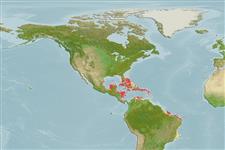Environment: milieu / climate zone / depth range / distribution range
นิเวศวิทยา
เกี่ยวกับทะเล,น้ำเค็ม เกี่ยวกับหินโสโครก. Tropical
Western Atlantic: Bermuda and southern Florida, USA to Bahia in Brazil.
ขนาด / น้ำหนัก / Age
Maturity: Lm ? range ? - ? cm
Max length : 18.0 cm TL เพศผู้/กระเทย; (Ref. 7251)
Inhabits sandy areas and seagrass beds, usually bathed by clear, oceanic waters. Feeds on small fish and invertebrates (Ref. 42064).
Life cycle and mating behavior
วัยเจริญพันธุ์ | การสืบพันธุ์ | การวางไข่ | เซลสืบพันธ์ของเพศเมีย(ไข่) | ความดกของไข่ | ตัวอ่อน
They migrate en mass towards the open sea and have leptocephalus larvae.
Robins, C.R. and G.C. Ray, 1986. A field guide to Atlantic coast fishes of North America. Houghton Mifflin Company, Boston, U.S.A. 354 p. (Ref. 7251)
IUCN Red List Status (Ref. 130435)
Threat to humans
Harmless
Human uses
การประมง: ไม่มีผลประโยชน์
ข้อมูลเพิ่มเติม
ชื่อสามัญชื่อพ้องกลไกการเผาผลาญพลังงานผู้ล่าการศึกษาเกี่ยวกับผลกระทบของสารประกอบทางเคมีที่เป็นอันตรายต่อสิ่งมีชีวิต ประชากร และสิ่งแวดล้อมการสืบพันธุ์วัยเจริญพันธุ์การวางไข่การรวมกลุ่มวางไข่ความดกของไข่เซลสืบพันธ์ของเพศเมีย(ไข่)Egg development
Age/Size
การเจริญเติบโต
Length-weight
Length-length
Length-frequencies
ความยาวต่างๆ
สัณฐานวิทยา
ตัวอ่อน
พลวัตของสัตว์น้ำวัยอ่อน
การทดแทนที่
อุดมสมบรูณ์
BRUVS
อ้างอิงการเพาะเลี้ยงสัตว์น้ำประวัติการเพาะเลี้ยงสัตว์น้ำสายพันธุ์พันธุศาสตร์ElectrophoresesอัตราพันธุกรรมโรคการแปรรูปNutrientsMass conversion
ผู้ร่วมมือรูปภาพหลายรูปStamps, Coins Misc.เสียงปลามีพิษ เช่น ปลาปักเป้าความเร็วรูปแบบการว่ายน้ำพื้นที่เหงือกOtolithsสมองวิสัยทัศน์
เครื่องมือ
Special reports
Download XML
แหล่งที่มาจากอินเตอร์เน็ต
Estimates based on models
Preferred temperature (Ref.
123201): 25 - 28.1, mean 27.4 °C (based on 604 cells).
Phylogenetic diversity index (Ref.
82804): PD
50 = 0.7500 [Uniqueness, from 0.5 = low to 2.0 = high].
Bayesian length-weight: a=0.00102 (0.00046 - 0.00225), b=3.06 (2.88 - 3.24), in cm total length, based on all LWR estimates for this body shape (Ref.
93245).
ระดับชั้นอาหาร (Ref.
69278): 4.0 ±0.63 se; based on food items.
Fishing Vulnerability (Ref.
59153): Low vulnerability (10 of 100).
Nutrients (Ref.
124155): Calcium = 60.8 [31.0, 123.7] mg/100g; Iron = 0.54 [0.31, 1.04] mg/100g; Protein = 18.2 [15.9, 20.9] %; Omega3 = 0.155 [0.065, 0.457] g/100g; Selenium = 38.2 [17.0, 82.0] μg/100g; VitaminA = 177 [46, 657] μg/100g; Zinc = 1.4 [0.9, 2.0] mg/100g (wet weight);
